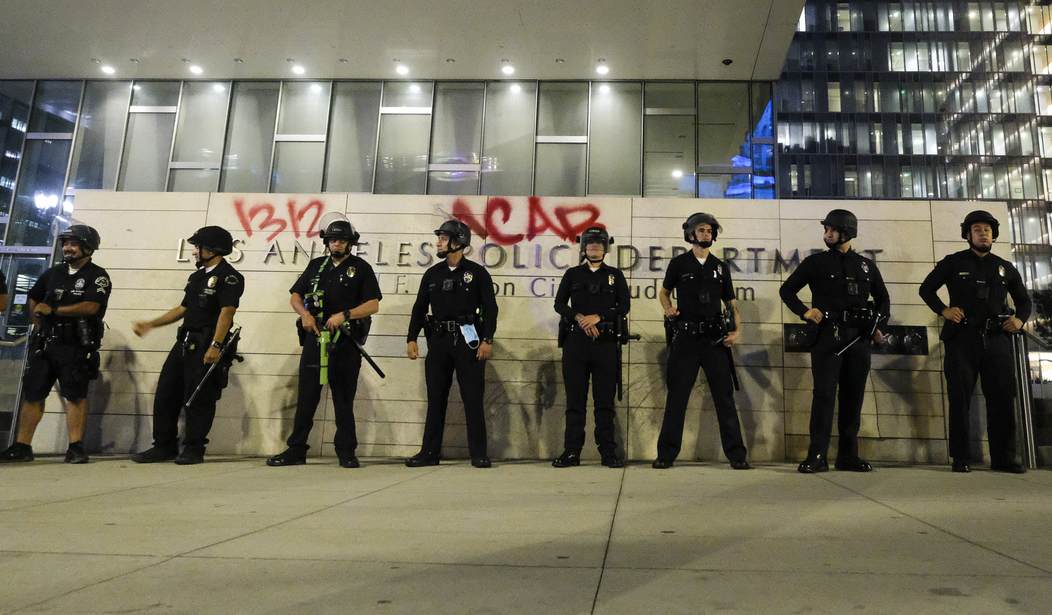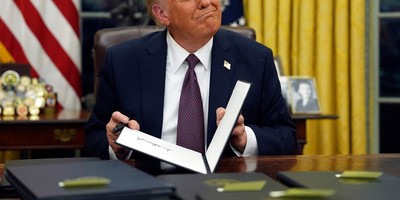What do George Washington, Thomas Jefferson, Theodore Roosevelt, Ulysses S. Grant, Father Junipero Serra and Christopher Columbus have in common?
None were Confederate generals, and yet all have had their statues torn down by mobs in the last few days -- or, in the case of Roosevelt, had New York's Museum of Natural History announce that a Roosevelt statue at the museum's entrance will soon be removed.
The mobs ripped down statues in Portland, Oregon, San Francisco, Minneapolis, and several other cities without any fear of police interference. The police might as well have been defunded, for all they did to protect America's historical monuments from vigilante violence.
Now add to the list Andrew Jackson, another president who was not a Confederate general. On Monday night, a mob attempted to tear down the Jackson statue in Lafayette Park in front of the White House. Since the statue is on federal ground, U.S. Park Police intervened, saving Jackson from crashing to earth.
It is unclear whether the District of Columbia police would have saved Jackson, who is a favorite of President Trump. Washington, D.C.'s mayor recently delighted in sending a message to Trump by designating 16th Street near the White House and Lafayette Park "Black Lives Matter Plaza," which just happened to give protesters a staging ground from which to attack Lafayette Park.
Back in August 2017, during a period in which activists sought the removal of statues of Confederate leaders, Trump made the classic slippery slope argument. "So this week, it's Robert E. Lee," he said. "I notice that Stonewall Jackson is coming down. I wonder, is it George Washington next week, and is it Thomas Jefferson the week after? You know, you really do have to ask yourself, where does it stop?"
A lot of people said that was ridiculous. The slippery slope argument "fails because there are obviously relevant distinctions that can be made between Washington and Jefferson on the one hand and Confederate leaders on the other," wrote Ilya Somin in The Washington Post on Aug. 15, 2017.
Recommended
Today's rope-wielding mobs don't see it that way. Try to tell them there are "obviously relevant distinctions" to be made, and they'll just head to the next target. In the current atmosphere, such reasoning is going exactly nowhere.
It could be that tearing down some historical monuments on the basis of contemporary views inevitably leads to the targeting of other historical monuments, based on other contemporary views. Once started, it is hard to stop.
So what is next? Probably more violence. After all, what is the disincentive for new mob attacks on historical monuments? Certainly not law enforcement. Yes, some of the more moderate-minded who supported the removal of Confederate statues are a bit embarrassed that the fire has spread to Washington, Jefferson and beyond, but they can't do anything to stop it.
And some influential voices seem quite happy with things as they are. Consider this: Mob members sprayed graffiti all over the statue of George Washington brought down in Portland. Among the graffiti was "1619." That was a reference to The New York Times' much-praised "1619 Project," which sought to argue that the United States was not founded between 1776 and 1789, in the period from the Declaration of Independence to the ratification of the Constitution, but in 1619, with the arrival of the first Africans brought to Virginia to be sold as slaves. The Times "aims to reframe the country's history, understanding 1619 as our true founding," the paper said. The theme of the "1619 Project" was that the United States, seen as a beacon of democracy, freedom and abundance, is in fact about racial injustice through and through.
So recently, noting the "1619" graffiti on the downed statue, the New York Post published an op-ed entitled "Call Them the 1619 Riots." "America is burning," author Charles Kesler said. "Looters have ravaged shops from coast to coast. And now they're coming for the statues -- not just of Confederate generals, but the republic's Founders, including George Washington..."
That caught the attention of the Times' Nikole Hannah-Jones, creator of the "1619 Project." Call them the 1619 riots? "It would be an honor," she tweeted. "Thank you." Hannah-Jones and the Times won the Pulitzer Prize for the "1619 Project." The project's lessons are being turned into a school curriculum. Given today's mood, more destruction surely lies ahead.
Byron York is chief political correspondent for The Washington Examiner.

























Join the conversation as a VIP Member